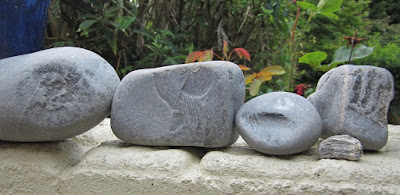'You choose, Deb.'
 Hmmm. Somewhere requiring minimal walking, plus eating/toilet opportunities, BUT with at least a modicum of interest for the attendants. I know ... Kilve on the Somerset coast, an old favourite of mine. Perfect.
Hmmm. Somewhere requiring minimal walking, plus eating/toilet opportunities, BUT with at least a modicum of interest for the attendants. I know ... Kilve on the Somerset coast, an old favourite of mine. Perfect.And it was perfect. Beautiful weather, an easy run down the M5 to Bridgwater and then up the A39 through sunlit pastures to the coast, diverting on the way to drive past Coleridge's Cottage in Nether Stowey, before swinging neatly across the road in Kilve and onto the forecourt of the Hood Inn with plenty of time to avoid the tractor bowling down the hill.
Only to look up and see it all boarded up.
I'd been looking forward to making the most of a precious half pint of Rich's Cider, even though, as I'd muttered to my niece, my mother would be sure to say 'you can't have any more, you're driving'. But clearly it wasn't to be. Disconsolately - and without phone signal to inform our journey - we meandered west until we reached West Quantoxhead, where there was a purpose-built inn on the side of the road with a bouncy castle and play area, and the dreaded word (for a vegetarian), Carvery.
'Perfect!' said my mother.
Well, if not perfect exactly, it turned out to be better than OK. Plus, they sold farmhouse cider. I took a sip. If, by any chance, it wasn't Rich's, it was pretty close.
'You can't have any more, you're driving,' said my mother.
Then back to Kilve and down the lane to the sea. On the way we stopped at the little white Church of St Mary the Virgin.
 The oldest thing in the church - predating it by a couple of hundred years - is the 12th century font, which is still beautiful despite someone's attempt to turn it into a punch bowl.
The oldest thing in the church - predating it by a couple of hundred years - is the 12th century font, which is still beautiful despite someone's attempt to turn it into a punch bowl. ... while the carved back of this pew in the choir dates from the 17th century.
And the mediaeval glass, I like that too.
Plus, the door has a sanctuary ring - always useful to know in these dark days.
On then to the end of the car park by the oil retort, which was built in the 1920s when it was discovered that there was oil-bearing shale in them there cliffs. If I ever get there and there's no plume of ivy smoking from the chimney, I'll be distraught.
Jane and I settled the (grand)parents on the bench and went for a fossick, to see if we could find some fossils to bring back to show my father.
 We found a few smaller fossils to take back to my father but by the time we got back, he'd disappeared, the warm, south-westerly breeze having proved too much for the combined efforts of his vest, shirt, jumper and zipped up anorak to keep him from feeling cold.
We found a few smaller fossils to take back to my father but by the time we got back, he'd disappeared, the warm, south-westerly breeze having proved too much for the combined efforts of his vest, shirt, jumper and zipped up anorak to keep him from feeling cold.  Rather concerned - since I had the car keys - we made our way back to the car park to find him ensconced on a seat in the neighbouring cricket field, looking victorious.
Rather concerned - since I had the car keys - we made our way back to the car park to find him ensconced on a seat in the neighbouring cricket field, looking victorious. Between the church and the sea, there's a chantry, which was founded in 1329 and which, it is believed, fell into ruin long before the Dissolution of the Monasteries.
These days, you can get cream teas and ice cream in the adjoining farmhouse ...
... commune with sparrows ...
... and watch the doves in the old dovecotes round the back ...
... but in the old days, as well as being used as a barn, it was associated with smugglers, who would bring their contraband up Kilve Pill from the coast and hide it there. This continued until 1848 when barrels of brandy were allegedly set alight, in order to destroy evidence when the revenue men appeared.
The chantry is now a Grade II listed building and Scheduled Ancient Monument, and deemed to be at the highest risk of collapse.
























Thank you! I love the circular walk from EQ to Kilve and back - beautiful in both directions.
ReplyDeleteLoved your previous post, too. X A.
Hello Ama - yes, it's a glorious walk, isn't it? Must get Colin to do it with me one of these days.
DeleteHope all well with you XXXXX